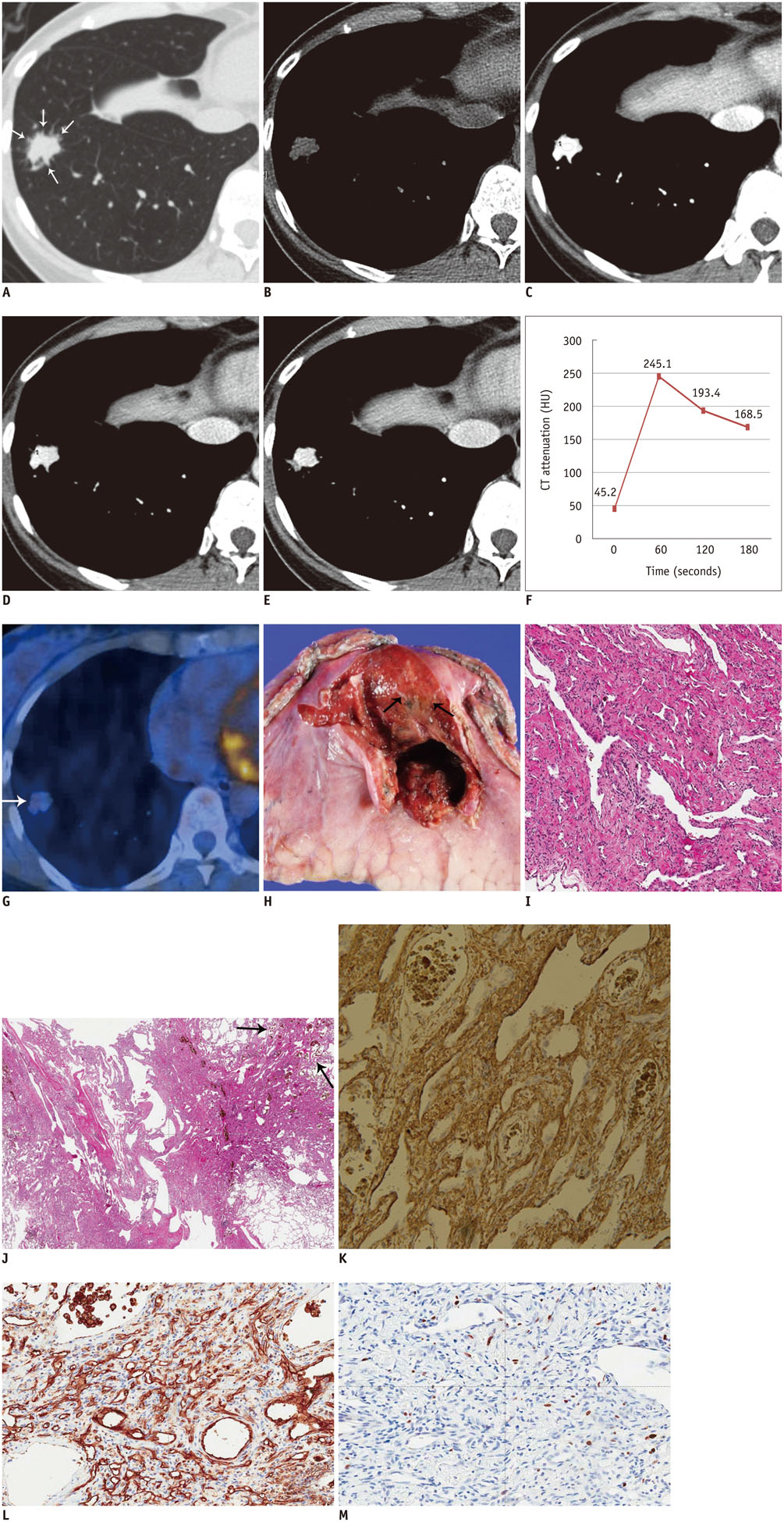Korean J Radiol.
2015 Oct;16(5):1166-1170. 10.3348/kjr.2015.16.5.1166.
Primary Pulmonary Low-Grade Angiosarcoma Characterized by Mismatch between 18F-FDG PET and Dynamic Contrast-Enhanced CT
- Affiliations
-
- 1Department of Radiology and Center for Imaging Science, Samsung Medical Center, Sungkyunkwan University School of Medicine, Seoul 06351, Korea. hoyunlee96@gmail.com
- 2Department of Pathology, Samsung Medical Center, Sungkyunkwan University School of Medicine, Seoul 06351, Korea.
- 3Department of Nuclear Medicine, Samsung Medical Center, Sungkyunkwan University School of Medicine, Seoul 06351, Korea.
- KMID: 2160785
- DOI: http://doi.org/10.3348/kjr.2015.16.5.1166
Abstract
- We report a rare case of primary pulmonary low-grade angiosarcoma on dynamic contrast-enhanced CT and 18F-fluorodeoxyglucose (FDG) positron emission tomography (PET)/CT imaging. A 38-year-old, asymptomatic woman was hospitalized because of an abnormality on chest radiography. A dynamic contrast-enhanced chest CT showed a 1.2 cm-sized irregular-margined nodule with strong and persistent enhancement in the right lower lobe. The lesion had low metabolic activity on an 18F-FDG PET/CT scan. The patient underwent a wedge resection for the lesion, and pathology revealed a primary pulmonary low-grade angiosarcoma.
MeSH Terms
-
Adult
Female
Fluorodeoxyglucose F18/*chemistry
Hemangiosarcoma/*diagnosis/pathology/radiography
Humans
Ki-67 Antigen/metabolism
Lung Neoplasms/*diagnosis/pathology/radiography
Multimodal Imaging
*Positron-Emission Tomography
Radiopharmaceuticals/*chemistry
Tomography, Spiral Computed
Fluorodeoxyglucose F18
Ki-67 Antigen
Radiopharmaceuticals
Figure
Reference
-
1. Chen YB, Guo LC, Yang L, Feng W, Zhang XQ, Ling CH, et al. Angiosarcoma of the lung: 2 cases report and literature reviewed. Lung Cancer. 2010; 70:352–356.2. Eichner R, Schwendy S, Liebl F, Huber A, Langer R. Two cases of primary pulmonary angiosarcoma as a rare cause of lung haemorrhage. Pathology. 2011; 43:386–389.3. Patel AM, Ryu JH. Angiosarcoma in the lung. Chest. 1993; 103:1531–1535.4. Weissferdt A, Moran CA. Primary vascular tumors of the lungs: a review. Ann Diagn Pathol. 2010; 14:296–308.5. Jeong YJ, Lee KS, Jeong SY, Chung MJ, Shim SS, Kim H, et al. Solitary pulmonary nodule: characterization with combined wash-in and washout features at dynamic multi-detector row CT. Radiology. 2005; 237:675–683.6. Young RJ, Brown NJ, Reed MW, Hughes D, Woll PJ. Angiosarcoma. Lancet Oncol. 2010; 11:983–991.7. Bastiaannet E, Groen H, Jager PL, Cobben DC, van der Graaf WT, Vaalburg W, et al. The value of FDG-PET in the detection, grading and response to therapy of soft tissue and bone sarcomas; a systematic review and meta-analysis. Cancer Treat Rev. 2004; 30:83–101.8. Eary JF, Conrad EU, Bruckner JD, Folpe A, Hunt KJ, Mankoff DA, et al. Quantitative [F-18] fluorodeoxyglucose positron emission tomography in pretreatment and grading of sarcoma. Clin Cancer Res. 1998; 4:1215–1220.9. Tokmak E, Ozkan E, Yağcı S, Kır KM. F18-FDG PET/CT Scanning in Angiosarcoma: Report of Two Cases. Mol Imaging Radionucl Ther. 2011; 20:63–66.10. Cucci E, Ciuffreda M, Tambaro R, Aquilani L, Barrassi M, Sallustio G. MRI findings of large low-grade angiosarcoma of the breast with subsequent bone metastases: a case report. J Breast Cancer. 2012; 15:255–257.11. Lim RF, Goei R. Best cases from the AFIP: angiosarcoma of the breast. Radiographics. 2007; 27:Suppl 1. S125–S130.
- Full Text Links
- Actions
-
Cited
- CITED
-
- Close
- Share
- Similar articles
-
- Supraclavicular Lymph Node Metastasis from Various Malignancies: Assessment with 18F-Fluorodeoxyglucose Positron Emission Tomography/CT, Contrast-Enhanced CT and Ultrasound
- Use of 18F-FDG PET/CT in Second Primary Cancer
- Uterine Epithelioid Angiosarcoma on F-18 FDG PET/CT
- Usefulness of Low Dose Oral Contrast Media in 18F-FDG PET/CT
- Incidental Bilateral Renal Oncocytoma in a Patient with Metastatic Carcinoma of Unknown Primary: a Pitfall on 18F-FDG PET/CT


